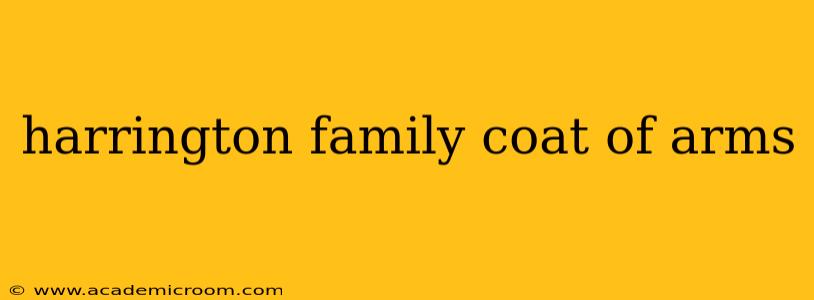The Harrington name, steeped in history and boasting a lineage stretching back centuries, is associated with several distinct coats of arms. Understanding the nuances behind these heraldic symbols requires delving into the complexities of family branches, geographical locations, and the evolution of heraldic practices. This guide aims to provide a comprehensive overview of Harrington coats of arms, clarifying common misconceptions and offering insights into their historical significance.
What is a Coat of Arms?
Before we dive into the specifics of Harrington coats of arms, it's crucial to understand what a coat of arms represents. A coat of arms is a unique heraldic design, a symbolic emblem historically granted to individuals or families to denote lineage, status, and achievements. These designs, often featuring intricate patterns, animals, and colors, were meticulously recorded and regulated, ensuring their distinctiveness. The specific elements within a coat of arms—the charges, tinctures, and crest—all carry symbolic meaning, often reflecting the family's history, values, or motto.
Variations in Harrington Coats of Arms: Why the Differences?
The Harrington family, spread across different regions and branching into numerous lineages over time, naturally resulted in variations in their heraldic representations. Several factors contribute to this diversity:
- Geographical Location: Different branches of the Harrington family, settling in various regions (England, Ireland, Scotland, and later, across the globe), might have adopted slightly altered versions or even entirely different coats of arms over time. Local heraldic practices and influences played a significant role.
- Granting of Arms: The process of obtaining a coat of arms historically involved a formal grant from a heraldic authority, and these grants could differ slightly based on the specific circumstances and the interpretation of the heraldic officers. Different branches might have sought grants independently, leading to variations.
- Evolution of Heraldic Practices: Heraldic design itself evolved over centuries. Styles, symbols, and rules changed, leading to natural variations in coats of arms even within the same family over time.
- Cadency Marks: To distinguish between different branches of a family, cadency marks—small additions or alterations to the basic design—were used to represent seniority and lineage. These marks further diversify the appearance of Harrington coats of arms.
Common Harrington Coat of Arms Elements: Recurring Motifs
While variations exist, certain elements appear frequently in coats of arms associated with the Harrington family. These recurring motifs offer clues into potential family connections and historical influences:
- Animals: Certain animals, like lions, eagles, or other heraldic beasts, might appear prominently. The specific animal and its posture often carries symbolic meaning, potentially hinting at family virtues or historical events.
- Colors and Tinctures: The colors (tinctures) used – such as red, blue, gold, silver, green, and black – also have symbolic importance. The combination and arrangement of these colors are crucial in distinguishing one coat of arms from another.
- Charges: These are the main figures or symbols within the shield, offering further clues into the family's history and identity.
How to Research Your Specific Harrington Coat of Arms
Researching your own Harrington family's coat of arms requires careful investigation and a methodical approach. Begin by:
- Gathering Family History: Compile as much genealogical information as possible, focusing on your direct ancestors and their geographical origins. This will help narrow down potential candidates for your family's specific coat of arms.
- Consulting Heraldic Records: Numerous heraldic resources and archives exist, both online and in physical locations. These archives contain historical records of granted coats of arms, offering invaluable information. However, bear in mind that accessing and interpreting these records may require expertise.
- Working with a Heraldic Expert: For complex or uncertain cases, it's always advisable to seek assistance from a qualified heraldic expert. Their knowledge and experience can significantly aid your research and ensure accuracy.
Are There Multiple Harrington Coats of Arms?
Yes, as explained above, the existence of multiple Harrington coats of arms reflects the complex history and branching lineages of the family. Attributing a specific coat of arms to your family requires thorough genealogical research to pinpoint your branch’s origins and any documented heraldic grants.
Can I legally use a Harrington Coat of Arms?
The use of coats of arms is regulated. Using a coat of arms that does not belong to your direct lineage could be considered misappropriation. Thorough research to confirm the rightful ownership is essential before displaying or using any coat of arms.
This guide provides a foundation for understanding the Harrington family coats of arms. Remember that this is a complex subject, requiring careful and detailed investigation to determine the specific coat of arms relevant to your family history.
